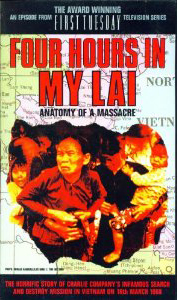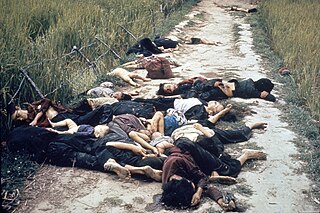
The My Lai massacre was a war crime committed by the United States Army on 16 March 1968, involving the mass murder of unarmed civilians in Sơn Mỹ village, Quảng Ngãi province, South Vietnam, during the Vietnam War. At least 347 and up to 504 civilians, almost all women, children, and elderly men, were murdered by U.S. soldiers from C Company, 1st Battalion, 20th Infantry Regiment, 11th Brigade and B Company, 4th Battalion, 3rd Infantry Regiment, 11th Brigade of the 23rd (Americal) Division. Some of the women were gang-raped and their bodies mutilated, and some soldiers mutilated and raped children as young as 12. The incident was the largest massacre of civilians by U.S. forces in the 20th century.
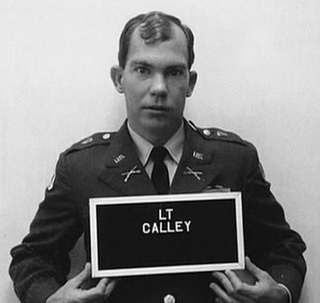
William Laws Calley Jr. was a United States Army officer convicted by court-martial of the murder of 22 unarmed South Vietnamese civilians in the My Lai massacre on March 16, 1968, during the Vietnam War. Calley was released to house arrest under orders by President Richard Nixon three days after his conviction. The United States District Court for the Middle District of Georgia granted him a new trial, but that ruling was overturned by the United States Court of Appeals for the Fifth Circuit. His initial life sentence having been modified to a term of 20 years and then further reduced to ten, Calley ultimately served three years of house arrest for the murders. Public opinion at the time about Calley was divided. After his dismissal from the U.S. Army and release from confinement, Calley avoided public attention.

Hugh Clowers Thompson Jr. was a United States Army officer, serving as a warrant officer in the 123rd Aviation Battalion of the 23rd Infantry Division. He is credited with ending the Mỹ Lai Massacre of the South Vietnamese village known as Sơn Mỹ on March 16, 1968, alongside Glenn Andreotta and Lawrence Colburn.

Estimates of casualties of the Vietnam War vary widely. Estimates can include both civilian and military deaths in North and South Vietnam, Laos, and Cambodia.
Lawrence Manley Colburn was a United States Army veteran who, while serving as a helicopter gunner in the Vietnam War, intervened in the March 16, 1968 Mỹ Lai massacre.

Varnado Simpson was a U.S. Army soldier who participated in the My Lai Massacre, torturing, murdering, and mutilating multiple South Vietnamese civilians. He committed suicide nearly 30 years later.
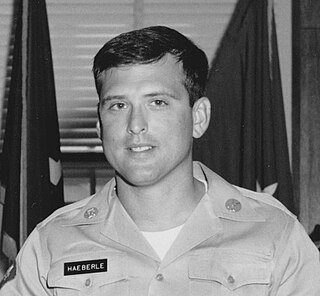
Ronald L. Haeberle is a former United States Army combat photographer best known for the photographs he took of the My Lai Massacre on March 16, 1968. The photographs were definitive evidence of a massacre, making it impossible for the U.S. Army or government to ignore or cover up. On November 21, 1969, the day after the photographs were first published in Haeberle's hometown newspaper, The Cleveland Plain Dealer, Melvin Laird, the Secretary of Defense, discussed them with Henry Kissinger who was at the time National Security Advisor to President Richard Nixon. Laird was recorded as saying that while he would like "to sweep it under the rug," the photographs prevented it.
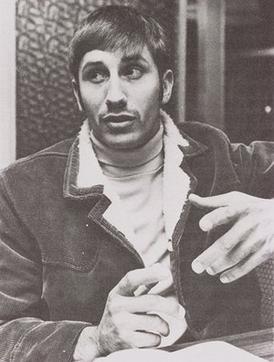
Ronald Lee Ridenhour was an American known for having played a central role in spurring the federal investigation of the 1968 Mỹ Lai massacre in Vietnam. When he first learned of events there, he was serving in the United States 11th Infantry Brigade in Vietnam. He gathered evidence and interviewed people before the end of his tour. After returning to the US in 1969, he wrote to President Nixon, members of his cabinet and two dozen Congressmen recounting what he had learned. A full-scale Department of Defense investigation eventually took place.
The "Winter Soldier Investigation" was a media event sponsored by the Vietnam Veterans Against the War (VVAW) from January 31, 1971, to February 2, 1971. It was intended to publicize war crimes and atrocities by the United States Armed Forces and their allies in the Vietnam War. The VVAW challenged the morality and conduct of the war by showing the direct relationship between military policies and war crimes in Vietnam. The three-day gathering of 109 veterans and 16 civilians took place in Detroit, Michigan. Discharged servicemen from each branch of the armed forces, as well as civilian contractors, medical personnel and academics, all gave testimony about war crimes they had committed or witnessed during the years 1963–1970.

The Sơn Mỹ Memorial is a memorial to victims of the My Lai Massacre, which took place on 16 March 1968 in Son My, Vietnam. This was a war crime committed by United States Army personnel involving the mass murder of unarmed civilians in Sơn Tịnh district, South Vietnam, during the Vietnam War. Mỹ Lai was actually the name of only one of four hamlets in the village of Sơn Mỹ in Quảng Ngãi Province. The event is referred to as the Mỹ Lai Massacre in the United States and the Sơn Mỹ Massacre in Vietnam.
The National Committee for a Citizens Commission of Inquiry on U.S. war crimes in Vietnam was founded in New York by Ralph Schoenman in November 1969 to document American atrocities throughout Indochina. The formation of the organization was prompted by the disclosure of the My Lai Massacre on November 12, 1969, by Seymour Hersh, writing for the New York Times. The group was the first to bring to public attention the testimony of American Vietnam War veterans who had witnessed or participated in atrocities.

The Sound of the Violin in My Lai is a short film that examines the history and legacy of the My Lai massacre, an incident of the Vietnam War in which hundreds of Vietnamese civilians were massacred by U.S. Army soldiers. The film investigates the effects of the massacre, with the story centering on the return of American soldiers Hugh Thompson and Larry Colburn to My Lai on the 30th anniversary of the event.
First Tuesday is a monthly television documentary strand that was shown in the United Kingdom on the ITV network and produced by Yorkshire Television. The subject matter is mainly social issues, and current affairs stories from around the world. It ran from 5 April 1983 to 2 November 1993, with programmes being shown on the first Tuesday of the month, hence the title. In 1993, Network First was a part replacement for First Tuesday.
My Lai is a documentary film detailing the My Lai massacre. It aired as an episode of American Experience on PBS.

The Vietnam War is a 10-part American television documentary series about the Vietnam War produced and directed by Ken Burns and Lynn Novick, written by Geoffrey C. Ward, and narrated by Peter Coyote. The first episode premiered on PBS on September 17, 2017. This series is one of the few PBS series to carry a TV-MA rating.
The Thuy Bo incident was the killing of civilians by U.S. Marines from 31 January to 1 February 1967, during the Vietnam War in Thủy Bồ village in Điện Bàn District, Quảng Nam Province 15 km southwest of Đà Nẵng, in an area close to the foothills of the Central Highlands and situated near the Bo Bo Hills. Vietnamese communist sources claim that the Marines massacred civilians here and the memorial erected to the event records 145 civilian deaths, mainly women, children and elderly men. US sources claim that 22 civilians were killed in two days of fighting between Marines and the Vietcong who occupied the village.

Operation Muscatine was a security operation conducted during the Vietnam War by the US Army in Quảng Ngãi Province, South Vietnam from 18 December 1967 to 10 June 1968. During this operation on 16 March 1968 the 1st Battalion, 20th Infantry Regiment and the 4th Battalion, 3rd Infantry Regiment carried out the My Lai Massacre.

Waging Peace in Vietnam: U.S. Soldiers and Veterans Who Opposed the War is a non-fiction book edited by Ron Carver, David Cortright, and Barbara Doherty. It was published in September 2019 by New Village Press and is distributed by New York University Press. In March 2023 a Vietnamese language edition of the book was launched at the War Remnants Museum in Ho Chi Minh City, Vietnam.

The Vietnam War Song Project (VWSP) is an archive and interpretive examination of over 6000 Vietnam War songs identified. It was founded in 2007 by its current editor, Justin A. Brummer, a historian with a PhD in contemporary Anglo-American relations from University College London. The project analyses the lyrics, and collects data on the genre, location, ethnicity, nationality, language, and time period of the recordings. It also involves the preservation of the original physical vinyl records. Additional items collected include cassette tapes, CDs, MP3s, record label scans, and sheet music.

Rape, among other acts of wartime sexual violence, was frequently committed against female Vietnamese civilians during the Vietnam War. It was an aspect of the various human rights abuses perpetrated by the United States and South Korea, as well as by local Vietnamese combatants. According to American political scientist Elisabeth Jean Wood, the sexual violation of women by American military personnel was tolerated by their commanders. American professor Gina Marie Weaver stated that not only were documented crimes against Vietnamese women by American soldiers ignored during the international legal discourse that occurred immediately after the conflict, but modern feminists and other anti-war rape campaigners, as well as historians, have continued to dismiss them.
